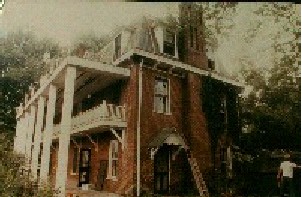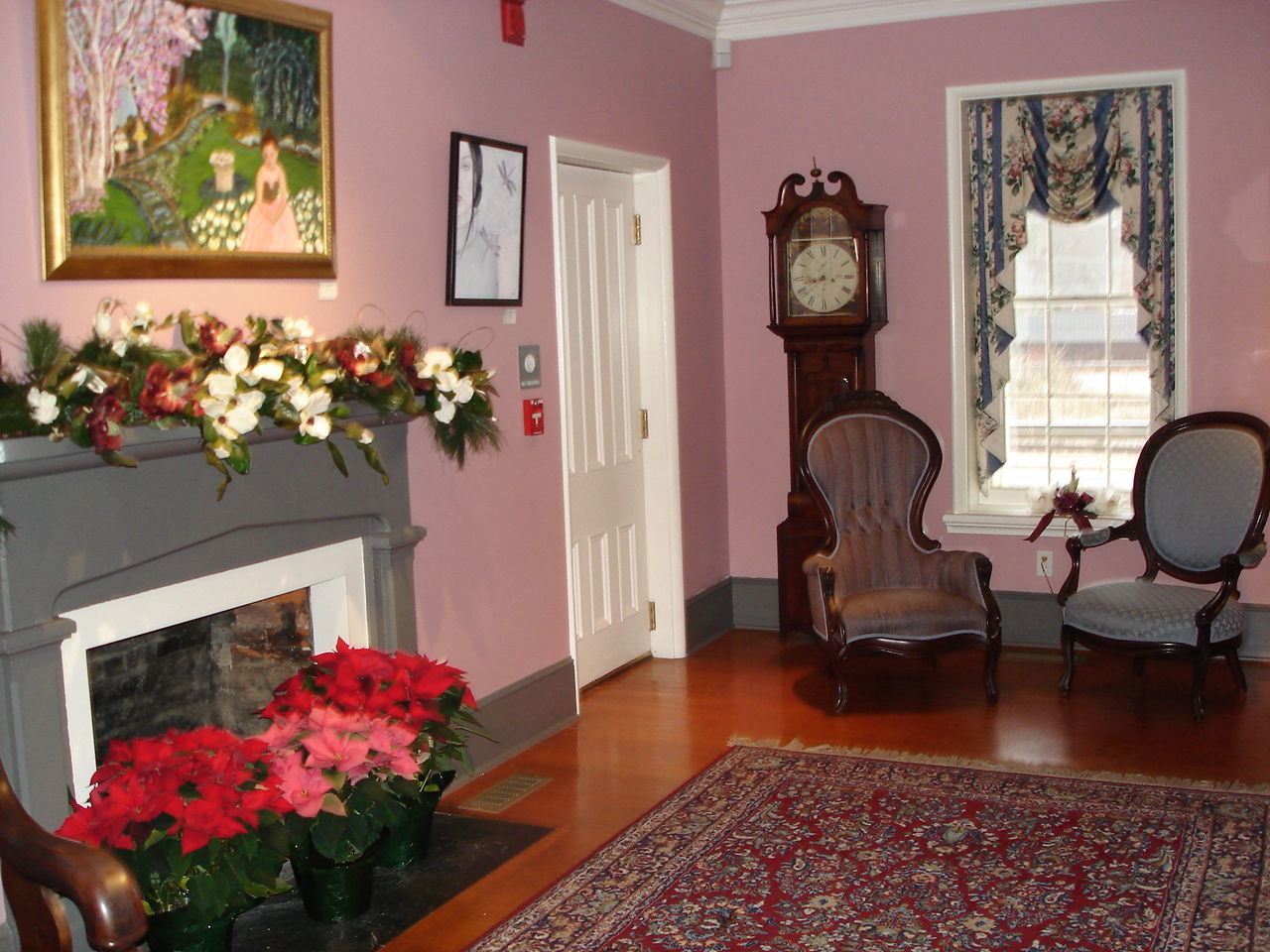- Home
- About Us
- Our History
- 5. Beyond the Bake Sale
Beyond the Bake Sale
1986-1988
December 1985 capped an exciting year with the formation of the Friends of the Page-Walker Hotel, the purchase of the Page-Walker by the Town and subsequent lease to Preservation NC and transfer to the Friends, and the reception for unveiling the official site sign. Architect Norma Burns had been hired. Placing a tarp on the roof, installing a fence, demolishing the rotting front porch, and boarding the windows had stabilized the Hotel. Pigeons were still a problem, however, and no matter how many fake owls and snakes were placed on the roof, the Hotel was the southeastern attraction for the winged creatures. Because of this “infestation,“ Dave Fischetti, Board member and engineer for the project, affectionately called the Hotel, the “Plaque-Walker.”
When 1986 rang in, we were in a unique situation. The destiny of the Page-Walker, then valued at $4000, was in our hands and we were faced with numerous challenges and decisions. All of us were volunteers, many holding full-time jobs, and the preservation process was a new venture for most of us. Our first challenge was the design phase. The overriding philosophy was to save as much of the original structure as possible while providing a place for active uses – arts, history and community celebrations and gatherings. We had been advised that the Hotel was not a good candidate for a “house restoration,” as the interior had been substantially changed over the years, owing to its use as a boarding house and private residence. No original furniture was left in the building and the structure had sustained heavy damage. It was extremely important to the Friends that the exterior be restored to its original state, and that the interior was faithful to the 1868 structure, yet functional for future use.
Norma Burns had experience in historic renovations and engaged us in the design process. Some of the discussion points were:
- Rather than place a “box” on the back of the building, the addition would
complement, not copy, the historic structure. The original brick of the
exterior of the historic structure at the connection of the addition
would be visible from the interior of the addition. The addition would
be visually “set-back” from the historic structure, and the major access
would be from the east.
- The east entry area would be wrapped with a porch so that the addition, on both the east and west sides, would have a "veranda" feeling.
- The enclosed first floor west staircase would be removed to create a larger performance/gallery space. The staircase formed a wall dividing the Walker’s sitting room from the dining room. At first, it was thought that columns would be needed to support the second and third floors because of the stair removal. However, Dave Fischetti designed a method of inserting steel beams throughout the building to provide an open and gracious gallery space. Dave insists that the Page-Walker is now the safest place to be in a storm! The other original staircases remain.
The NC Department of Cultural Resources, Division of Archives and History, gave tremendous support throughout the design phase. Paul Fomberg and Paul Stephenson provided assistance in paint research, mortar analysis (every brick needed repointing) and design recommendations to protect the historic integrity of the structure. The design phase took most of 1986.
At the same time, the second daunting challenge was to identify sources for the estimated $350,000 needed for the restoration and renovation as well as to raise awareness of the importance of the project. We couldn’t begin the first phase of the project, demolition, until we had the funds in hand to cover the costs. We quickly became aware that the cost of the project would be at least 20% higher than anticipated because we were forced, through lack of funds, to phase the project. That meant for every phase of the renovation – demolition, exterior restoration, addition, subsequent basement, first floor and later, second and third floors – we needed to call for separate bids over years.
We also needed to increase community awareness and support for the Page-Walker. Fundraisers became an effective way to not only raise the needed funds but also to communicate our message. The fundraising effort had three major prongs during most of 1986: public relations, grant writing, and “events.” Van Carpenter of Real to Real volunteered his time to write and produce a tape/slide show that was taken to civic organizations, primarily by Kirk and Linda Fuller. Grants were submitted to organizations such as Z. Smith Reynolds, the Hillsdale, Mary Duke Biddle and Kresge foundations, and United Way. And thanks to our Board members, notably Pati Schetzina and Barbara Brown, numerous fundraisers were held, at least one every other month.
During 1986, we held the first annual Fabulous Flea, a huge flea market that took place at South Hills Mall, thanks to the support of owner David Martin. A Gay Nineties Ice Cream Social, replete with banjo players, art show, Cary High School Jazz Band, antique car show and Victorian fashion show drew more than 700 people to the grounds of the bunting-draped Page-Walker. Needless to say, because of the overwhelming response to the event, we were running to stores to buy every gallon of ice cream! Our Lazy Daze location, on Academy Street in front of the Cary Baptist Church, was transformed into another Victorian Ice Cream Parlor.
Other businesses and non-profit organizations held events for the renovation. Bunkey’s Car Wash gave a day’s profits to the effort, and the Wake County Weavers’ Guild raffled a shawl for the Hotel. We co-sponsored a Christmas Home Tour with the Cary Women’s Club and an evening event at Charlie Brown’s Dinner Theater with the Cary Women’s Club. Each fundraiser contributed, at the most, $2500. The responses to our grant writing efforts were slow or disappointing.
So it was in the fall of 1986 that one of those memorable, life-changing moments occurred. Barbara Brown, Board member, invited my husband and me to her home for afternoon dessert. Her husband, Thack, worked for the former Burroughs-Welcome and was very involved in arts activities in the county. Over a delicious fruit tart, Thack looked at me and said, “Anne, I think we’re beyond the bake sale.” He realized that there was no way that we could raise the needed funds, and still live to tell about it, through only fundraisers. He encouraged us to hire outside consultants who could conduct a feasibility study and create a road map for a capital campaign. It was the best advice we could have received at that time, and that afternoon at the Brown’s home goes down as one of the major turning points of the endeavor. Thack was familiar with effective arts consultants, and after an interview process, we hired Dr. Michael Marsicano, executive director of the Durham Arts Council and an associate, Mark Rountree. The consultants prepared a case study that summarized the plans for the Page-Walker and related costs, and then, during the spring of 1987, interviewed 25 business and community leaders to determine the feasibility of the project. I remember telling Michael and Mark that we didn’t want to hear that the project wasn’t feasible, just how we could make it work. In the meantime, our fundraisers continued and we hosted a reception for Mayor Harold Ritter and the Town Council (Koka Booth, Tom Brooks, Bill Garmon, Bob Godbold, Bob Hinshaw and Chuck Montgomery), introducing them to Norma Burns and sharing our progress. We understood the importance of keeping the Council connected to our effort, and unknown to us at the time, witnessed the invaluable results of this connection.
We received the consultant’s report in the summer. Their first three recommendations were affirming. All who were interviewed supported the proposed uses (arts, history, and community celebrations), and felt that the effort should be a private/public partnership of the Friends and Town of Cary. A recommendation was presented to expand the Board of Directors to include experienced and influential representatives from the business community and elected officials. We subsequently had an extremely effective Board that could have been labeled the “Who’s Who of Cary/Wake County.” It was the fourth component of the report that knocked us off our chairs!
The proposed cost of the project would not be $350,000, but $744,000 with an additional $96,000 for first-year operating costs. It was also determined that the Friends had the resources to raise only half that amount, not including the monies that had already been spent on stabilization and design phase. So, as we had in the beginning of the project, we made our way to the Town Council on our knees and asked if the Town could match each dollar that we raised from the community. Mayor Koka Booth and the Council approved the request, and the Capital Campaign was launched in December of 1987, under the able co-chairmanship of Daphne Ashworth and Regina McLaurin, assisted by every member of the Board. We had another mountain to climb, but at least we had a plan!



